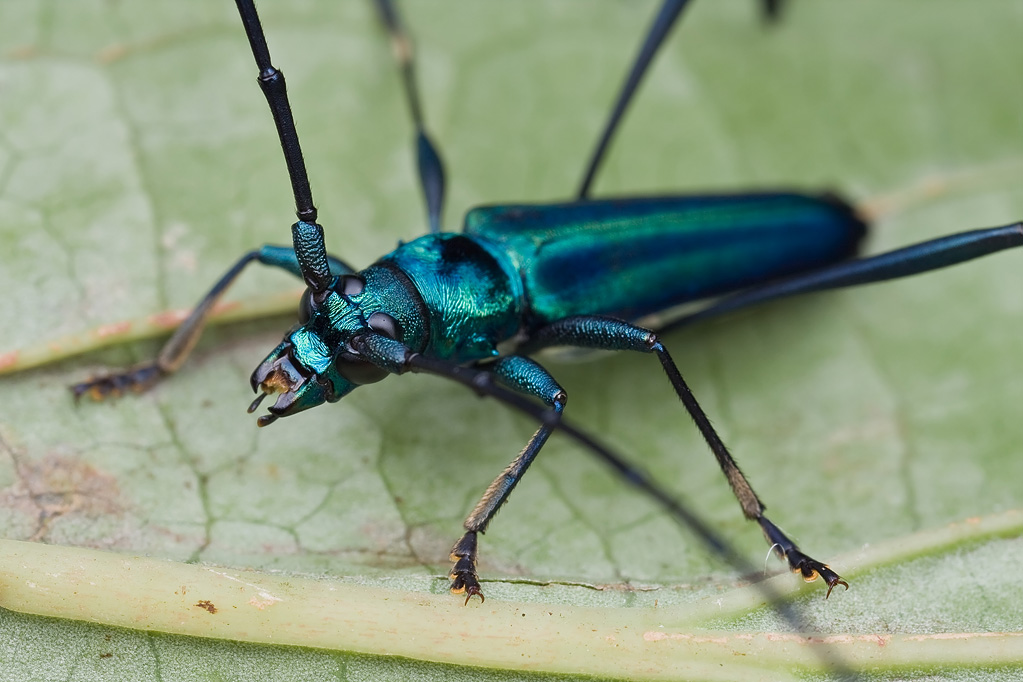| Author |
 Topic Topic  |
|
|
Les
Member Purpuricenus
 
Thailand
106 Posts |
 Posted - 19/10/2010 : 02:15:41 Posted - 19/10/2010 : 02:15:41



|

Photographed at Danum Valley Research Centre, Sabah.
Can someone ID this?
Thanks. |
|
|
Francesco
Forum Admin
    
Luxembourg
9454 Posts |
 Posted - 19/10/2010 : 22:00:31 Posted - 19/10/2010 : 22:00:31




|
It is surely a Chelidonium, but I am uncertain between C. gahani Achard, 1911 and C. punctigerum (Pascoe, 1869).
Have you taken further photos? Something about its size? |
 |
|
|
Les
Member Purpuricenus
 
Thailand
106 Posts |
 Posted - 20/10/2010 : 03:46:30 Posted - 20/10/2010 : 03:46:30



|
| No further photos I'm afraid. My colleague who took the photo, and whose permission I got to post it here, advises that it was 15-20mm in length, and that it was photographed on Clidemia hirta (Hairy Clidemia or Koster's Curse). |
 |
|
|
Francesco
Forum Admin
    
Luxembourg
9454 Posts |
 Posted - 20/10/2010 : 08:53:41 Posted - 20/10/2010 : 08:53:41




|
With a size like that, it is more close to Chelidonium gahani Achard, 1911, which also has blue rather than black elytral bands.
The only character that does not seem to correspond is the missing of a blue spot on the apical margin of the pronotum.
The catalogue by Heffern did not have further species; nonetheless, Vives, Bentanachs & Foo have recently described some Callichromatini from Northern Borneo. |
 |
|
|
Les
Member Purpuricenus
 
Thailand
106 Posts |
 Posted - 20/10/2010 : 09:48:59 Posted - 20/10/2010 : 09:48:59



|
| Thank you very much, Francesco. |
 |
|
|
Carlo
Member Rosenbergia
   
Italy
1138 Posts |
 Posted - 20/10/2010 : 18:47:10 Posted - 20/10/2010 : 18:47:10



|
| I think it's Borneochroma shuteae Bentanachs & Chew Kea Foo, 2008, a new genus and species described from Sabah, Borneo |
 |
|
|
Francesco
Forum Admin
    
Luxembourg
9454 Posts |
 Posted - 20/10/2010 : 18:52:00 Posted - 20/10/2010 : 18:52:00




|
Very well Carlo, this will be clarify this question.
Which are the main differences between this new genus and Chelidonium? |
 |
|
|
Carlo
Member Rosenbergia
   
Italy
1138 Posts |
 Posted - 20/10/2010 : 21:01:58 Posted - 20/10/2010 : 21:01:58



|
The original differentation in French:
antennes bien plus longues, beaucoup plus longues que le corps chez le mâle, plus longues que le corps chez la femelle
scape avec l'angle apicale plus développé mais arrondie
antennomères carénés dès le 3° article (4° chez le Chelidonium)
disque du pronotum avec des sillons transversaux antérieurs et postérieurs et également un bande longitudinal médiane, lisses (disque uniforme sans ligne longitudinale médiane chez Chelidonium)
|
 |
|
|
Carlo
Member Rosenbergia
   
Italy
1138 Posts |
 Posted - 20/10/2010 : 21:08:28 Posted - 20/10/2010 : 21:08:28



|
et encore... chez Chelidonium le rebord antérieur du pronotum est très marqué, rugueux, le postérieur grossièrement ponctué strié
les fémurs plus longs que l'apex élytrale (aussi longs ou peu plus longs chez Chelidonium)
Tarse postérieur comprimé latéralement (non comprimé chez Chelidonium)
Che fatica!!!! |
 |
|
|
Francesco
Forum Admin
    
Luxembourg
9454 Posts |
 Posted - 20/10/2010 : 22:08:05 Posted - 20/10/2010 : 22:08:05




|
Hence, Borneochroma seems to have intermediate characters between Chloridolum and Chelidonium...
1000 Thanks, Carlo! |
 |
|
|
Les
Member Purpuricenus
 
Thailand
106 Posts |
 Posted - 21/10/2010 : 03:01:32 Posted - 21/10/2010 : 03:01:32



|
| Yes, indeed, thanks very much Carlo. |
 |
|
| |
 Topic Topic  |
|


